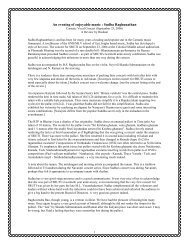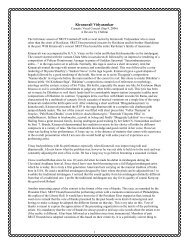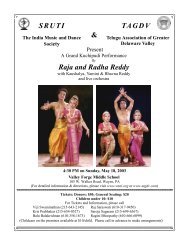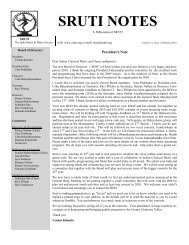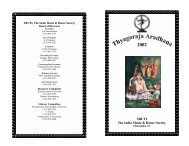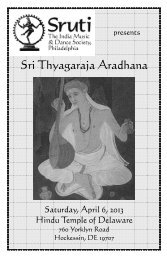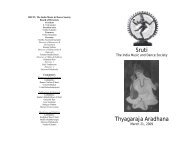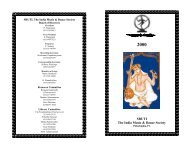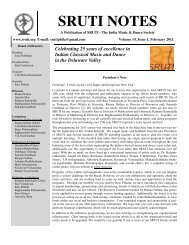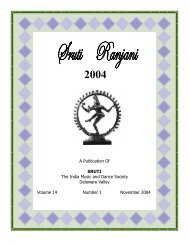Create successful ePaper yourself
Turn your PDF publications into a flip-book with our unique Google optimized e-Paper software.
M.S. Sheela’s Vocal ConcertA <strong>Review</strong> (May 5, 2001)By Yeshwantha PrabhuWhen a musician sings alapanas and kritis at a slow or moderate speed, with appropriate and lavishgamakas, he or she can bring out the raga bhava and ragachhaya and the delicate nuances of a ragaand the rasikas can relax and enjoy the singing, and feel the ananda that Carnatic music can give.With this thought in mind I sat in the beautiful and luxurious McShain Theater with apprehension andanticipation. M. S. Sheela started her concert with the varna Ninne Kori in Kanada at a leisurely andproper speed, and I soon found myself relaxing, putting talam and nodding. In her clear, high-pitchedangelic voice, she sang the varnam very well. Next she sang Vinayaka nata phala dayaka (Mohanam),not often heard at concerts. I was already beginning to be impressed! Then she sang Thyagaraja’s SogasuJuda tarama ni in Kannadagowla. TVS, TNS, Maharajapuram Santanam, DKJ, DKP, and many othershave sung this kriti. Next, with a brief alapana in Todi, she sang Sharadeye karuna varidhiye exceedinglywell. Muthiah Bhagavatar’s Samayamide nannu brochutaku in the rare raga Budhamanohari was quitepleasant to hear. For a brief period I wondered why Muthiah Bhagavatar was so fond of “inventing” ragas,and composing in very rare ragas. Sheela brought my wandering mind down to earth with a beautiful butbrief rendition of Reetigowla alapana. One of the prominent princes of the raga kingdom, Reetigowladeserves an elaborate rendition. Smt. Radika Mani played the alapana wonderfully well and drew a welldeservedapplause. I was touched by Sheela’s soulful rendition of Harikatha Shravana mado. (It was stillringing in my ears, while at work, two days later!). So far six kritis rendered without an elaborate alapana! Iwas beginning to feel a twinge of disappointment.Next she sang a melodious, elaborate, methodically developed Pantuvarali, bringing out the ragaswaroopamagnificently. It was the first, fully developed alapana. I felt it should have come much earlier. RadhikaMani, who is an excellent violinist, was more than a match. Her Pantuvarali was superb. I leaned to therasika sitting next to me and whispered, “She is going to sing Dikshitar’s Ramanatham Bhajeham”. Theway an alapana is rendered often hints at the composition to follow! Musicians such as SanjaySubramaniam and T.M. Krishna are adept at conveying the kriti they have chosen through their alapana. Itwas most appropriate that she chose this majestic kriti as the main item. Both the neraval and kalpanaswaras were superbly rendered. The thani avartanam was excellent. Anoor Dattatreya Sharma played themridangam very well. At this stage, even A.V. Kashinath, the kanjira player, who seemed sleepy anddistracted throughout the concert, played with vigor, as if rejuvenated. R.Satya-kumar, the ghatam playerwas excellent. I thought of the incomparable Sukanya Ramagopal, the ghatam player who accompaniedSheela during her 1996 concert. The audience was thrilled at the layavadya lahari, although in the beginning I felt that three layavadyas were two too many. I have attended many memorable concerts where themridangam was the only laya vadya.Next Sheela sang a shloka in ragamalika. I liked the Hindola and Amritavarshini. She then sang Govindagopal a gopika vallabha, also in ragamalika. The rasika sitting next to me told me that female vocalists areusually reluctant to sing compositions made popular by the great M.S. because of the unavoidable andusually unfavorable comparison. Just then, coincidentally, Sheela began to sing Swati Tirunal’s beautifulragamalika kriti, Bhavayami Raghuramam with Saveri as the main raga. Having heard the wonderfulrenditions by M.S. and also Maharajapuram Santanam numerous times, I felt Sheela sang it in a somewhathurried way, without taking care to bring out the beauty of the sangatis in Mohanam and Natakuranji. Had Inot heard M. S’s recording, would I have felt the same way? I wondered.Then she sang seven brief kritis in succession, without alapanas. Tungateer a virajam in Salagabhairavi,and four Purandaradasa’s kritis: Narayana yenniro in Saranga, Tarakka Bindige, Ramanama payasakke,and Yelliruvano Ranga in Sindhubhairavi. Although almost all these songs were in response to requestsfrom the audience, it was apparent that she has a special affinity to Purandaradasa’s kritis. She sang withgreat bhava and her pronunciation was impeccable. These were followed by Thyagaraja’s Gandhamupuyyaruga in Punnagavarali and P. T. Narasimhachar’s Aalisu Krishnana kolalina kare.1
A great musicologist and one of the most knowledgeable persons I knew, the late Sri Vishveshwaraiyya,had told me, “Musicians have a duty to show respect to the Trimurtis and the Pitamaha, so they must sing acouple of kritis of Tyagaraja, Dikshitar and Purandaradasa and one kriti of Shyama Shastri also, and thenthey can choose a few other composers they like. A musician should sing at least three or four alapanaselaborately and two short alapanas, and it would be nice to include a RTP also.” When I think of the mostmemorable concerts I have been to, I am not surprised that most of them correspond to this formula. Sheelasang one elaborate alapana only, and she sang one ghana kriti only, which might explain why I felt the wayI did when the concert was over. Although it was a good concert, it was not a satisfying one. I haveobserved that at concerts arranged by <strong>Sruti</strong>, CMANA and the Telugu Association, the audience consists ofa significant number of very knowledgeable people, many of whom are concert grade musiciansthemselves. These rasikas flock to a concert with the hope of listening to not just a few well-rendered kritis,but quite a few well-rendered alapanas also. It would be nice if a musician keeps this in mind and tries toquench the rasikas’ thirst for alapanas.Sheela could have sung fewer kritis, and included at least one ghana-kriti of Tyagaraja and one more ofDikshitar’s. This concert had an abundance of “tukdas” and a shortage of ghana kritis, and an enigmaticscarcity of alapanas. And because I have attended several of her excellent concerts over the years, I wasquite astonished.A word must be said about the innumerable requests and notes sent to the musicians by the rasikas throughtheir children, while Sheela was singing. The rasikas have an obligation to remember that the musiciansneed to concentrate and that sending a note while they are singing or playing the violin can be verydistracting. Perhaps the organizers should have reminded the audience before the concert to refrain fromdoing so.[Yeshwanth Prabhu is a chemist and an aspiring vocalist. He learnt Carnatic vocal from flutist SriGopalakrishna Iyyer, and composer/vocalist Sri T.N.Bala.]2
Violin Duo Concert by Mysore Nagaraj and ManjunathA <strong>Review</strong> (May 5, 2001)By Kamakshi Mallikarjun<strong>Sruti</strong> teamed with Triveni Arts Group to give us a unique double treat on Saturday, May 5th 2001 thatstarted with this lovely concert of lilting melodies. Having enjoyed listening to each of these accompanists,it was another treat to hear them play together in perfect unison!The concert started with a sparkling rendition of the Durbar, Adi Tala Varnam Chalamela. A short sketchof the raga Nattai was followed by Shri Maha Ganapathim. Then, Manjunath delineated the ragaGarudadhwani triggering memories of the English Note that Madurai Mani Iyer made famous(Garudadhwani, the converse of Bilahari, has the notes of Sankarabaranam in arohana and Mohanamin avarohana). They played Thyagaraja's Thatva Meruga Tharama with charming kalpana swarams..After a bhava-laden alapana of Abhogi by Nagaraj, came Sabapathiki. This was followed by a rareDikshithar kriti in raga Gurjari. The main item was Bhajare Re Manasa, preceded by a beautiful alapanain Raga Abheri. The tani by Srimushnam Raja Rao was lovely, especially his varying modulation of thesound.The artistes were deluged with requests and they graciously played a lot of them. After the tani, the songswere Tunga Theera Virajam (Salaga-bhairavi), Baro Krishnayya (Ragamalika), Akhilandeshwari(Dvijavanti), a bhajan in Vasanthi, Krishna Nee Begane (Yaman Kalyan), Naan Oru Vilayattu Bommaiya(Navarasa Kanada) Jagadodharana (Kaapi), and finally Lalgudi's Thillana in Raga Thilang. Mysore Nagarajand Manjunath embellished these melodies with deft touches: one playing the high note and the other thelow note in Krishna Nee Begane. They have such a beautiful Gayaki style … their violins seem to besinging the words.A most enjoyable concert!(Kamakshi Mallikarjun is a software engineer and a music and dance enthusiast. )3



